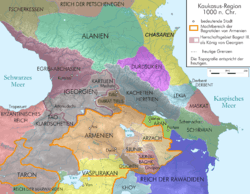Kingdom of Artsakh
| Kingdom of Artsakh | |||||
| |||||
|
| |||||
 Artsakh as vassal of the Armenian kingdom around 1000 | |||||
| Capital | Kapan, Haterk, Vaykunik, Hohanaberd | ||||
| Languages | Armenian | ||||
| Religion | Armenian Apostolic | ||||
| Government | Monarchy | ||||
| King | Hovhannes (John) Senecherib | ||||
| 1000 | |||||
| History | |||||
| - | Established | 1000 | |||
| - | Subdivision of the kingdom | 1182 | |||
| - | Acquisition of Dizak and Gardman | 1261 | |||
| - | Assassination of Hasan Jalal, last king of Artsakh | 1261 | |||
The Kingdom of Artsakh (Armenian: Արցախի թագավորություն) is the modern name given to the medieval eastern Armenian state on the territory of Artsakh (present-day Nagorno-Karabakh), Gardman and Gegharkunik.[1] Contemporary sources referred to it as the Khachen. The royal house of Artsakh was a cadet branch of the ancient Syunid dynasty and was named Khachen, after its main stronghold. The kingdom emerged when John-Senecherib (Hovhannes-Senekerim) acquired the royal title in 1000.
The monarchs of Artsakh maintained an internationally recognized sovereign status, though in the early 13th century they accepted Georgian, then Mongol suzerainty.[2] They lost the royal title after the assassination of Hasan-Jalal (1214–1261) by the Ilkhanid ruler Arghun, but continued to rule Artsakh as a principality, which from the 16th century comprised five Armenian melikdoms and lasted until the early 19th century.[1] The descendants of the kings of Artsakh played a prominent role in the history of Artsakh as far as the 20th century.
The Kingdom of Artsakh is also known as the Kingdom of Syunik-Baghk.
See also
References
- ↑ 1.0 1.1 Hewsen, Robert H (2001). Armenia: A Historical Atlas. Chicago: University of Chicago Press. pp. 118–121. ISBN 0-226-33228-4.
- ↑ Hewsen, Robert H. "The Meliks of Eastern Armenia: A Preliminary Study." Revue des Études Arméniennes. NS: IX, 1972, pp. 255-329.
Further reading
- Robert H. Hewsen. "The Kingdom of Arc'ax" in Medieval Armenian Culture (University of Pennsylvania Armenian Texts and Studies). Thomas J. Samuelian and Michael E. Stone (eds.) Chico, California: Scholars Press, 1984. ISBN 0-89130-642-0.
| ||||||||||||||||||||||||


